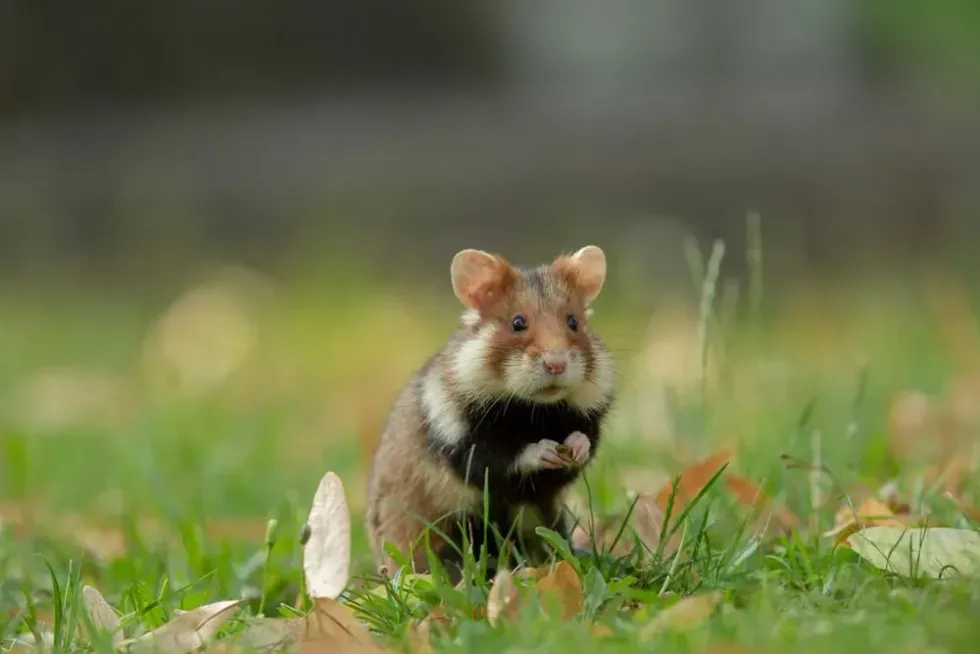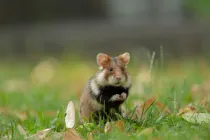Looking for something absolutely adorable and fluffy to be kept as a pet? We think the European hamster might be the one for you!
The European hamster (Cricetus cricetus) is known for its adorable looks, large cheek pouches, and colorful bodies. These little furry animals are the only members of the Cricetus genus.
They are present in multiple parts of Europe and Asia. They are known for the black fur on their bellies, giving them the name of ‘Black-bellied hamsters’! They are also known by other names, such as the Eurasian hamster or even the Common hamster.
Farmers find these animals worrisome, as the European hamster attack is known to affect their harvests. Hence, they are always kept away from places following agricultural practices. Unfortunately, this animal has been listed as ‘Critically Endangered’ in the IUCN Red List.
Delighted to know about the European hamsters? You might have a good time reading about rodents, such as the wood mouse and the white-footed mouse!
European Hamster Interesting Facts
What type of animal is a European hamster?
The European hamster is a type of rodent.
What class of animal does a European hamster belong to?
The European hamster belongs to the class Mammalia.
How many European hamsters are there in the world?
The total European hamster population in the wild accounts for about a few hundred only.
Where does a European hamster live?
The population of these small rodents is widely spread throughout its natural habitat in central and eastern Europe, as well as Asia.
What is a European hamster's habitat?
The European hamster habitat is often grasslands, meadows, agricultural fields, hedges, gardens, and other vegetated areas with loamy or clayey soils.
Who do European hamsters live with?
Common hamsters are solitary beings, usually living by themselves until the breeding season.
How long does a European hamster live?
The common hamster is said to live up to eight years in captivity.
How do they reproduce?
The reproductive seasons of European hamsters are between the months of April to August. The female hamsters have a gestation period of only about 18 days.
The adult hamsters are involved in multiple matings during the breeding period. The female runs around in figure eight, trying to invite her male counterpart. If interested, the male hamster would join her behind and make loud mating calls.
Back in the 20th century, it is said that female hamsters gave birth to about 20 babies in a year. However, now only three to seven offspring are born in a year.
The new batch of altricial pups is born with their ears and eyes closed. Their little toes are all fused together, and their teeth pierce through their gums. As days pass by, the pups slowly develop, and their body functions begin working. The adult female (sow) can get back to mating immediately after giving birth.
The little pups are weaned for a month’s time. The sow is capable of giving birth thrice in a year. The pups grow older and mature when they turn one and a months old.
What is their conservation status?
The IUCN Red List of Threatened Species has enlisted the conservation status of this species as Critically Endangered.
European Hamster Fun Facts
What do European hamsters look like?

This little furry creature has striking black fur on its chest and belly, giving it an alternate name of the ‘black-bellied hamster.’ The hamsters have chestnut brown fur on their backs, along with white patches. Their tails are small, though well furred with shorter hair, compared to the rest of their bodies.
The little feet are white. They have dark eyes and a small pink nose.
The whiskers on their faces are stiff and standpoint. Each forefoot has five small pads on its soles, while the hindlimbs have six small pads. Their ears are triangular and directed upward, being about 0.787-1.38 in (2-3.5 cm) long.
Male hamsters are comparatively larger than females. This species also has large, elastic cheek pouches which help them move around.
How cute are they?
Common hamsters are absolutely heartwarming and cute!
How do they communicate?
These small furballs have many different ways of communicating with the other hamsters!
Body Language
Having a small size, their body needs to adapt to various situations and express their emotions. In order to pacify the other hamsters, one might look away and hold out one of their paws.
To decide the alpha among two hamsters, they would circle each other and sniff the bodies, with each one taking turns to lie down and allow the other one to sniff, bite or topple them.
If the hamster stands upright, pointing their claws at their threat, they are trying to be aggressive.
If a hamster begins chewing or gnawing at things around it, it might mean the little one is bored.
If a hamster flicks its tail towards the sky and hunches the back upward, it is trying to calm the situation at hand.
If a hamster wants to surrender in a fight, they will lie on their backs and freeze, not charging against their opponent.
If two hamsters are rolling against each other, they are fighting, and it would only end if one of them surrenders. If the little hamster is stretching while yawning, it actually might not be a yawn- it might be a way to emote its excitement!
You might see the hamster pointing its ears back when it is too tiring to do anything!
Vocal Communication
The tiny squeaks and calls made by these hamsters have different meanings. If a female hamster is ready to mate, she will make loud calls to invite the male. When the male finds his way to the female, he makes shrill calls to announce that he has found her.
Due to poor vision, these animals might also use echolocation to navigate. Aggression or oppression can be conveyed when the hamster is chattering its teeth. If the hamster is continually squeaking, it might be in need of help. This furball is known to hiss if it is not in a good mood.
How big is a European hamster?
Standing 8-14 in (20.32-35.6 cm) tall, these common hamsters are as tall as about three to four teacups stacked vertically. Their tails are about 1.5-2.5 in (3.8-6.4 cm) long.
How fast can a European hamster run?
We are not aware of the actual speed a European hamster can attain. However, hamsters can run as fast as 3-6 mph (4.82-9.65 kph).
How much does a European hamster weigh?
At birth, the pups weigh between 0.151- 0.215 oz (4.3-6.1 g). An adult Cricetus cricetus weighs about 7.8–16.2 oz (220-460 g).
What are the male and female names of the species?
A male hamster is called a boar, while a female hamster is called a sow.
What would you call a European baby Hamster?
A baby hamster is called a pup.
What do they eat?
The European hamster has a lot of vegetarian constituents in its diet. It feeds on legumes, seeds, vegetables, crop harvests, grass. It is also known to munch down on smaller insects like termites, smaller rodents, insect larvae, and other invertebrates such as snails. Usually, on farms, it feeds on vegetables such as beans, potatoes, cabbages, peas, and beets.
Are they dangerous?
This black-bellied species is absolutely not dangerous!
Would they make a good pet?
European hamster pets are one of the best choices for a friendly companion.
Did you know...
The black-bellied hamster is a crepuscular as well as a nocturnal species, being highly active after twilight and even after the sunsets.
Their habitat includes a complex burrowing arrangement.
The common hamster is absolutely adorable with its large chubby cheeks. But these have a purpose! These cheek pouches help the hamster in carrying food. This food is stored in separate food storage chambers.
These storage chambers are used to store food between 4.4-14.3 lb (2-6.5 kg)! You might be wondering why is this so important? Well, between the months of October to March, the European hamsters hibernate. They wake up once every five to seven days and eat the food stored in these food chambers.
With a small gestation period, this species can give birth multiple times in a year.
Why are European hamsters endangered?
The European hamsters were once trapped for their soft fur.
The exact reason for the decline of their population is unknown. However, some contributing factors include natural habitat loss, climatic changes, pollution, and poaching for fur.
Luxembourg’s Court of Justice pointed out that France had not taken sufficient measures to protect the Common hamsters. Thus, in 2014, the country of France initiated a program to encourage captive breeding. Under this program, 500 hamsters were to be released on a reserved agriculture habitat, and the farmers of these fields would be paid accordingly.
Which type of hamster is the friendliest?
The friendliest of all hamsters is the Syrian hamster! These little ones are absolutely lovable towards their human companions. However, if you are looking for a furball that is friendly with humans as well as other hamsters, we would recommend the Russian dwarf hamsters!
Syrian hamsters are absolutely easy to bond with. They are also known as the ‘golden hamsters’ or the ‘teddy bear hamsters.’ Their populations are concentrated in northern Syria as well as parts of Turkey.
There is not much effort to be taken to tame them, and they won’t even bite you if they are comfortable. You can begin your friendship by feeding these small rodents from your hand.
This will develop a good trust between you and them. Since these are among the larger ones in the hamster clan, they are easy to cuddle with and hold as well. They are a little laid back and would enjoy being in your company.
Maintenance and food aren't much of an issue either. They are a little violent against other hamsters, so it is always recommended to keep them alone in an enclosure.
However, they need constant attention from their human friends. You can spend quality time with these stressbusters and relax!
Russian dwarf hamsters are smaller in size and absolutely adorable too! Humans might be a little frightening, but in some time, they would absolutely relax and enjoy your company!
You can also keep another companion with them, and they would be completely adjustable with the new hamster. They are almost half the size of the Syrian hamster. They are found in the wild regions of Kazakhstan, Siberia, Mongolia, and Manchuria.
Learn more about some other hamsters from our pages on Roborovski dwarf hamster facts and Chinese hamster facts.
You can even occupy yourself at home by coloring in one of our free printable European hamster coloring pages.









